This authentic Korean Kimchi recipe is a simplified version of my grandmother's complicated recipe. It's called "Mak Kimchi," an 'easy' and 'care-free' version that you can make any time of the year with just a few ingredients.
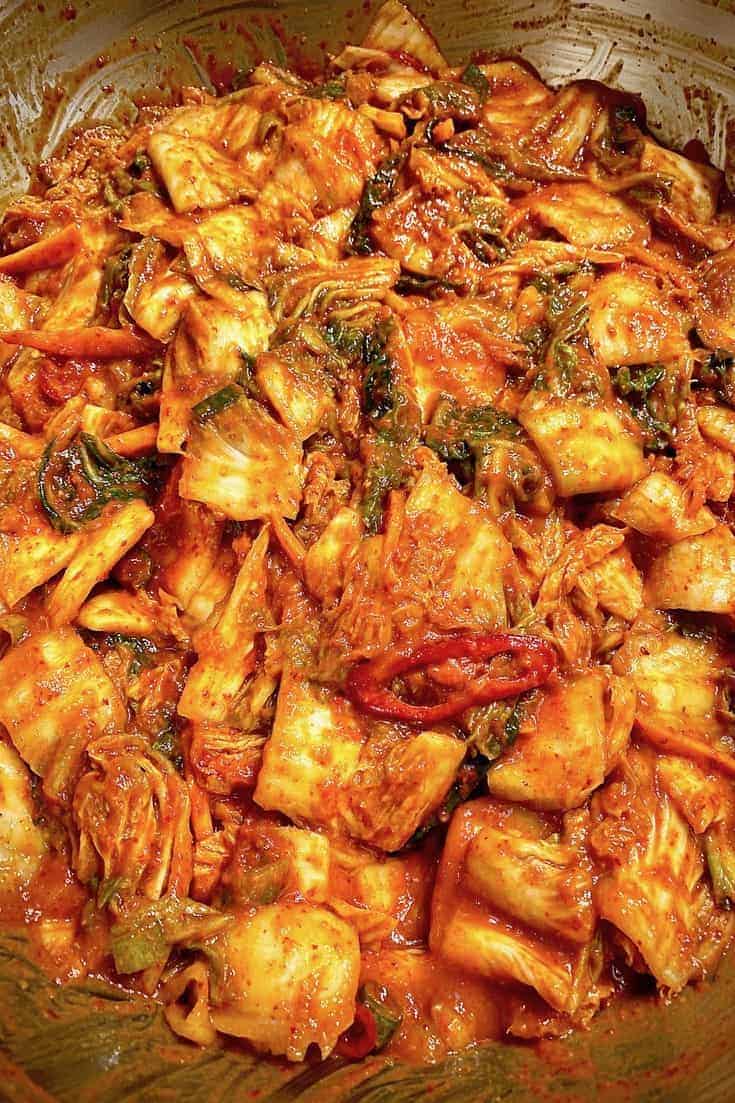
Some people say Koreans are among the leanest and healthiest people on the planet. I don't know about that but I do believe kimchi has something to do with our health. We make kimchi with cucumbers, oi-so-bagi, and when kimchi is very ripe, we make kimchi fried rice.
We can't live without this savory fermented cabbage seasoned with all spices and aromatics. And while some recipes can get complicated, I simplified the authentic Korean kimchi recipe so I can teach my children how to make it.
Intro
Why is Kimchi so popular?
Recent studies say that it prevents cancer, helps with digestion because of probiotics and is a great anti-inflammatory food because of all the seasonings and herbs that go in it. And it's true. Whenever I feel nauseous or have a stomach upset, a small sip of kimchi liquid calms it down.
The funny thing is, kimchi was not that popular when I was growing up in the 70's and 80's in Queens, NY. If people knew or heard about kimchi back then, it was because of M*A*S*H*, a sitcom comedy depicting American soldiers in Korea during the Korean War. In fact, I had to brush my teeth 3 times before leaving the house in fear that people would jump out of the way, after smelling kimchi from my breath.
But now, Queens is the mecca of Asian food and culture and kimchi is in every foodie and health conscious shoppers' grocery list. Kimchi is so "hot" these days, pun intended, that all the non-Koreans are making, eating, and demanding kimchi! People seem to be fine with the term, "fermented cabbage" when I describe what kimchi is. That was never the case.
Kimchi is to a Korean as ketchup is to an American. You can eat a meal without it, but it tastes so much better with it. In fact, when I eat pizza or used to eat a hamburger, I sometimes craved kimchi along with them. The crisp, crunchy, spicy cabbage with a hint of sour taste, cleansed my palate after eating meat. I don't eat it with every meal but I always have a jar in the fridge like I have ketchup.
The garlicky odor can smell stinky when you open the jar initially but the spicy garlicky aroma is something you have to experience to know its addicting quality. Just ask an old friend of mine who told me recently that he tried to smuggle a jar through an airport security once and now he is blacklisted by the airline. Joking aside, next to carrying a weapon on board, carrying a jar of kimchi through the security checkpoint will definitely put you on the "No Fly" list or clear out the airport before you can say, "kimchi!" So don't even try it.
Then, why would I recommend such a vile smelling dish?
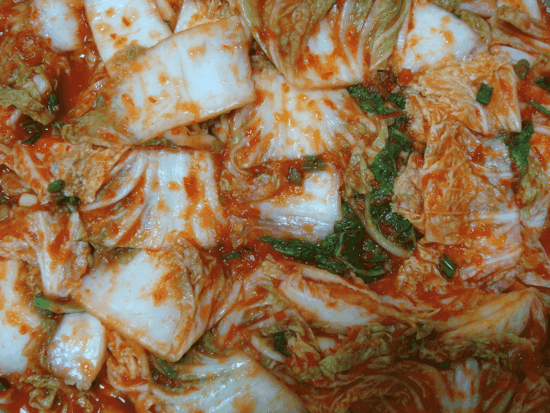
Why is Kimchi so good for you?
Kimchi is packed with vitamins A, B, and C and immune system-boosting phytochemicals. Its main ingredient, fermented cabbage, contains lactic acid, which helps with digestion and may weaken infections. But the biggest benefit may be from lactobacilli in kimchi - healthy bacteria that helps with digestion stops and even prevents yeast infections. Several years ago, Korean researchers found chickens infected with the avian flu recovered more quickly after being fed an extract of kimchi. More recently, a study at the University of New Mexico suggested that eating cabbage might help ward off breast cancer.
Kimchi is low in calories, rich in dietary fiber, low in fat, and low in carb. Some believe that kimchi has kept obesity at bay in Korea (although, since American fast food joints have been popping up everywhere in Korea, there have been increased cases of obesity. Damn those Big Mac's and KFC's!). And what's even better, when kimchi gets 'old' or over-ripen, it is used in everything from soups to pancakes. Every piece of kimchi is used up - nothing is wasted. My idea of a perfect gastronomic experience.
There are some naysayers who cite Koreans and Japanese having higher rates of stomach cancers due to fermented foods but that's been attributed to various factors and not just eating fermented foods. But one thing for sure, kimchi has been on the top of the list of foods to try as a result of recent researches done on the health benefits of kimchi here, here and here. And so many others. I can tell you, personally, it has helped me on many occasions when my immune system was on a strike.
Growing up, my mom would make a hot bean sprout soup for me and she would put some spicy kimchi in the soup whenever I had the flu or a cold. It seemed to speed up the recovery. And if nothing else, the spicy hot steam would clear up my sinus and I could breathe easier. Kimchi broth was also an elixir for indigestion as my mom would make me take spoonfuls of it whenever I had a stomach virus. And even if I was not in the mood to eat anything by mouth, I tolerated little spoonfuls of Kimchi broth.
Gimjang Kimchi vs. Mak Kimchi
The thing is, it is labor intensive to make kimchi, especially if you are making it for the year in the winter, which is called 'Gim Jang.'
Back in the day, women in the 'village' would gather and make kimchi, literally, all day long for two days. And when they were done, they would divide up the portions equally, and they would store them in huge clay vats that they bury in their backyard for the winter. This method was used to preserve and slow down the fermentation process so that they can have kimchi throughout the brutally cold Korean winters without having to make it so often.
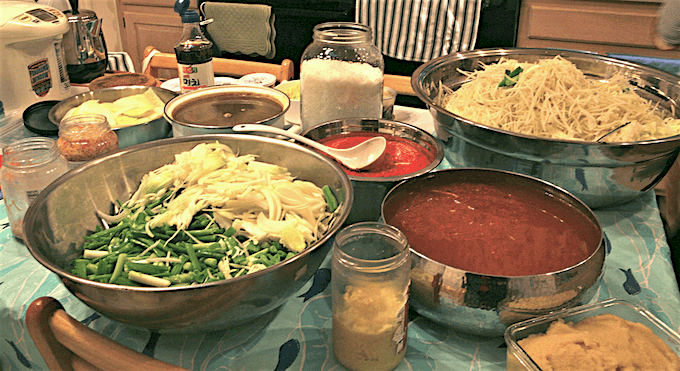
This is a small glimpse of "Gim Jang" production my mom and I go through every winter.
We normally make kimchi with intact Nappa cabbage leaves and stuffed them with the ingredients above. Then, they are stored in these special boxes for the kimchi refrigerator. Yes, there is such appliance to slow down the fermentation so it keeps kimchi longer.
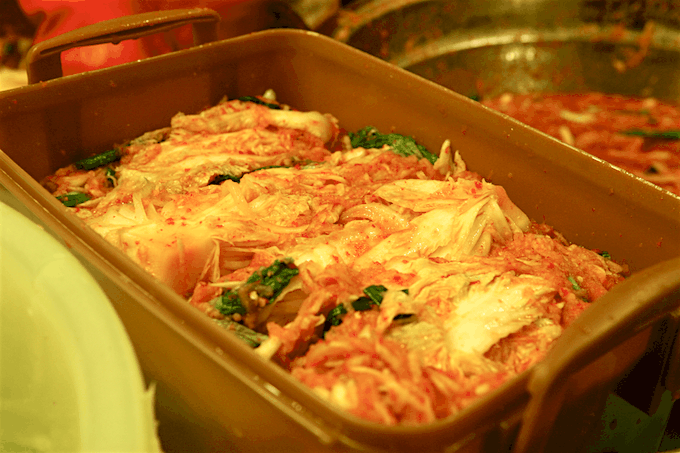
Anyway, this kind of traditional kimchi-making ritual has been simplified for the modern day a bit, but still, making even a small jar of kimchi by myself has always terrified me since it seemed too monumental to even fathom.
Making kimchi, using a 'secret' recipe that was handed down through generations, is like making your grandma's apple pie with her secret recipe. Every woman has a different way of making it and there is a sense of pride and mystery that shroud a good kimchi recipe.
So here is my 'secret', ridiculously easy authentic Korean kimchi recipe. (Forgive me Grandma for this 21st century watered down, simplified version.) This has been a long post already but here are some of my kimchi making tips.
Pro Tips
1. Time - It takes at least three days to make kimchi so don't think you'll start the darn thing at 3 PM and have it for dinner. There's no shortcut in kimchi making.
2. Vegan or Not? - traditionally kimchi has some sort of fish or shrimp extract in it, depending on which region it comes from. Many store bought kimchi has some sort of fish sauce in it so you have to read the label if you want to make it vegan . Fish sauce adds extra umami - the briny, salty, extra oomph- the main reason why we add it. But you can omit it if you want to keep it as vegan. There's also sugar added for faster fermentation. Some people add straight up sugar but others make a sweet rice or regular white rice porridge. For this recipe, I don't use sugar but I do use white rice slurry to feed the microbes.
3. It's the salt - revered Kimchi masters would tell you, the real secret to great kimchi is all in the salt. Use it too sparingly and you'll have a stringy mushy mess. Use it too much, you'll end up with a just salty goopy mushy mess. But use it just right - and you know how it's never a 'tablespoon' of this and 'teaspoon' of that but a 'dash' of this and 'smidgen' of that - and you'll be good to go. But I did learn one solid fact; use good quality Sea Salt. Never table salt or even kosher salt. You don't want highly processed salt like table salt with iodine or kosher salt with different sodium content. I recommend good quality sea salt - fine or coarse - with high mineral content.
4. Fresh pepper or pepper flakes? - [UPDATE] In my original recipe, I used "Ancient Sweet Red Pepper" because it wasn't as spicy as using gochugaru and since gochugaru was hard to find online. But now, you can find it on Amazon or any Asian grocery store. So I updated the recipe to use gochugaru and of course, you can use the proportions I listed here OR you can use more, depending on how much 'heat' you can take. You can also add a couple of spicy chili peppers to add color and more 'heat.' Or you can omit them and just use gochugaru.
If you are going to use gochugaru, packaged Korean red pepper flakes, make sure it's from Korea. Many brands are produced or processed in China and they don't taste the same as Korean grown and processed. Even the Korean produced, if the pepper flakes are old and not dried in the sun, they taste stale. And if you don't have an experience with certain brands, they might be too spicy and you won't know until you use it. Unfortunately, the packages do not tell you the scoville number - grades of spiciness - so you'll have to experiment to see what brands you like.
Ready? Here is the ultimate authentic kimchi recipe even my grandma would be proud of.
Ingredients
- 3 Napa Cabbages
- ½ C to 1 C - coarse sea salt
- 1 c gochugaru (or more for spicier kimchi)
- 10 medium-sized cloves of garlic
- 1 medium yellow onion
- 2" ginger
- ½ c fish sauce (optional)
- ½ c fermented baby shrimp (optional)
- ½ c cooked white rice (optional)
- 1-2 c cold filtered water (optional)
- 2 carrots (cut in matchsticks)
- 2 spicy red chili peppers
- 1 c chopped scallions (green onions)
Equipment
- 2 large mixing bowls
- wide mouth 1 gallon glass jar
- blender [I love Blendtec's Twister Jar (use 'drkarenslee' for 10% off) for blending fibrous ginger]
- cutting board
- knife
Instructions
1. Take off the outermost leaves from the Napa cabbages that are dirty and wilted. With a knife, cut the head down the middle for about 2 inches and separate the rest of cabbages in half with your hands. Fill the big bowl with cold water, and wash the cabbages while separating each layer carefully. Wash in between the leaves thoroughly to get rid of all the dirt hidden within the leaves.
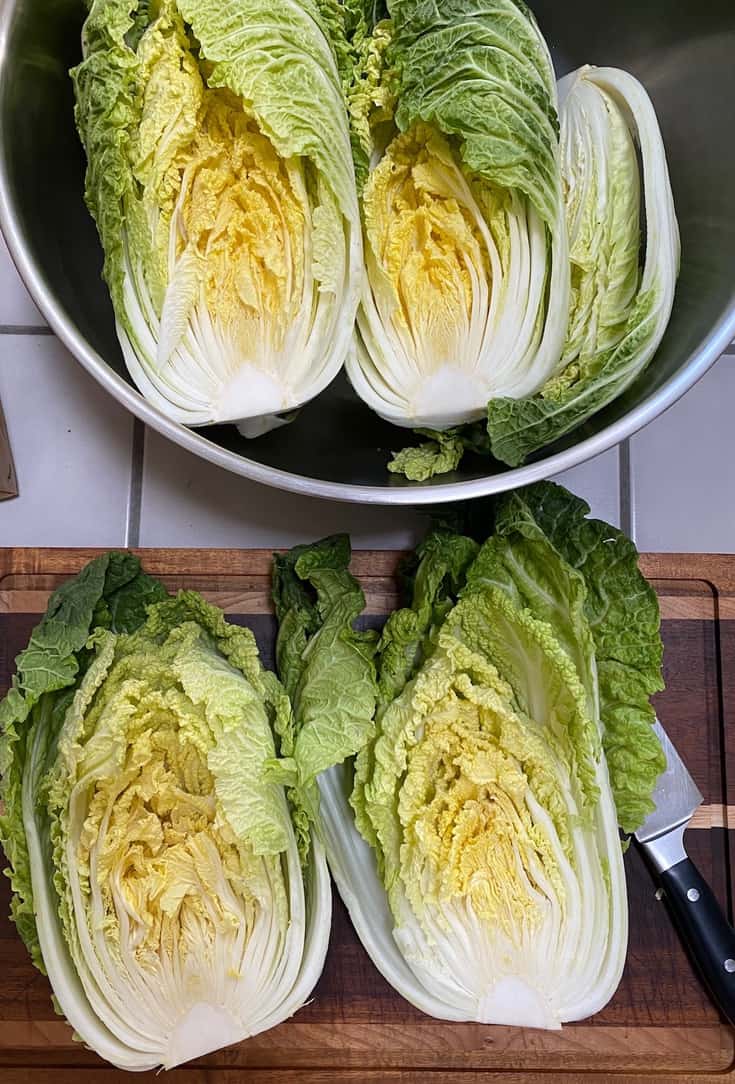
2. Drain well, chop the leaves in one-inch widths and put them in a large mixing bowl. Sprinkle salt evenly - about 1 teaspoon of salt to a hand full of cabbage, in layers until all the cabbage pieces are mixed in salt. Cover loosely, and store the cabbage in a cool place overnight - or for at least 5 hours.
2. There will be a little bit of liquid formed in the bottom of the bowl when the leaves get marinated in salt. Mix the cabbage mixture and then, rinse under cold water to taste. If it's salty enough, then, you are ready to proceed but if it's not, then, add more salt, one teaspoon at a time. If you add more salt, wait another a couple of hours, and then, taste again. If it's too salty, rinse the cabbages before adding the rest of the ingredients.
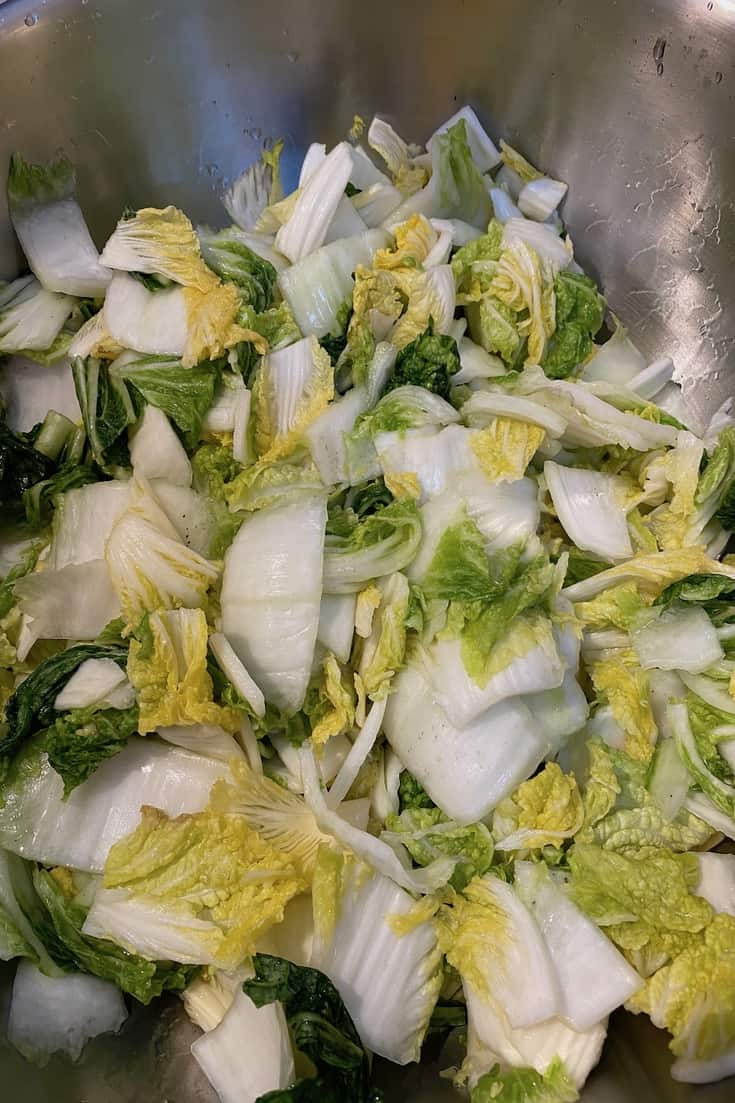
3. If you are happy with how salty it is, then, you are ready to add the rest of the ingredients.
4. Carbs like apple or Asian pear or white rice slurry or sugar is optional, but they help in feeding the microbes to speed up the fermentation process. And the result is so much different than if you don't use it. If you want to use the rice slurry, add ½ white rice with 1 cup of water to the blender with these ingredients. If you want to use sugar, use 3 tablespoon of white sugar. If you want to use fruits, cut them in big chunks and add with the rest of the ingredients in the blender.
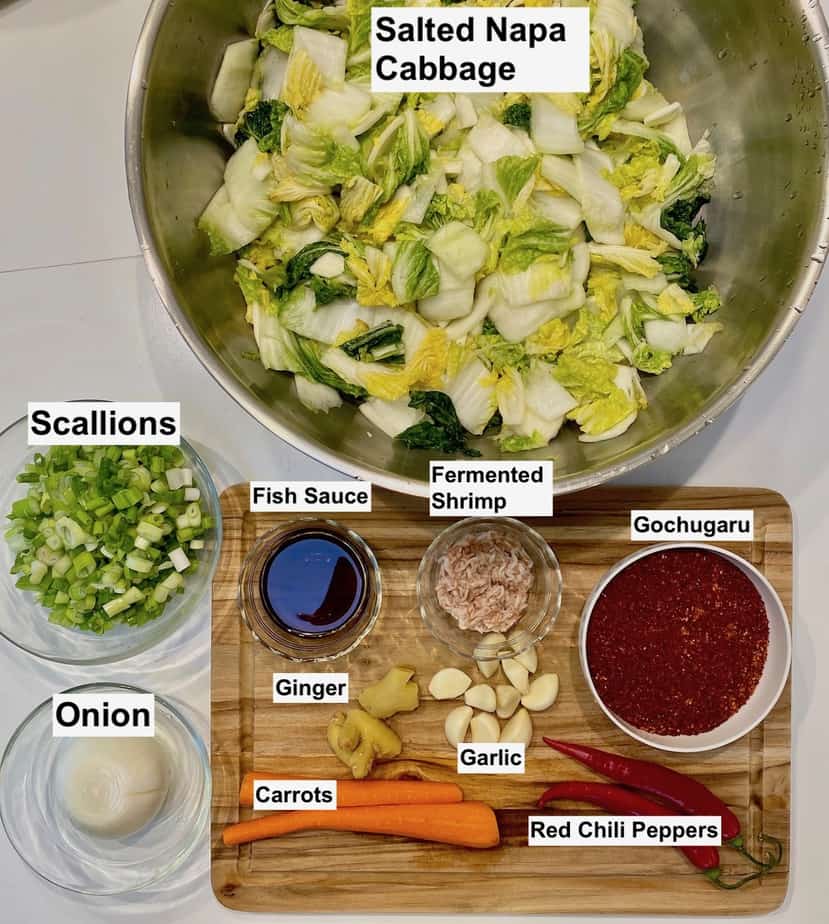
4. Add fish sauce, fermented shrimp, garlic, onion, ginger, gochugaru, and rice slurry or sugar or fruits, if you're using, to a food processor or a blender (don't use the jar you use to make margaritas, otherwise, your guests won't like the garlic tasting margaritas after making kimchi in it) and puree. If the mixture is too thick, add more water until the consistency becomes like ketchup.
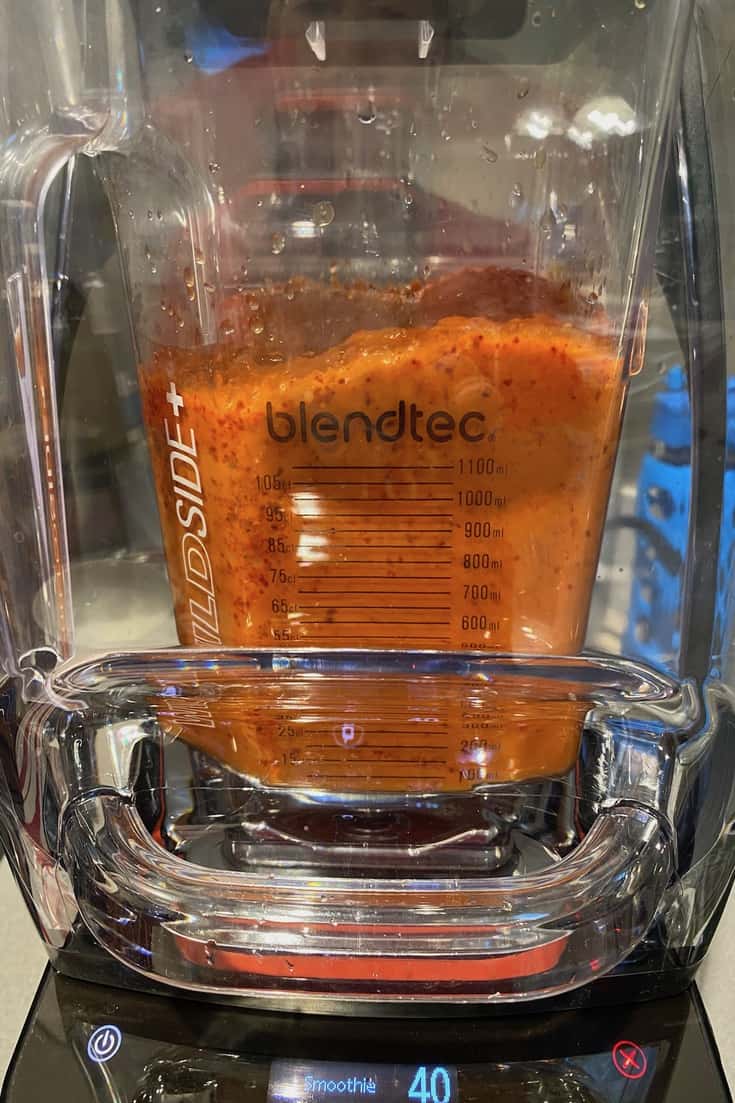
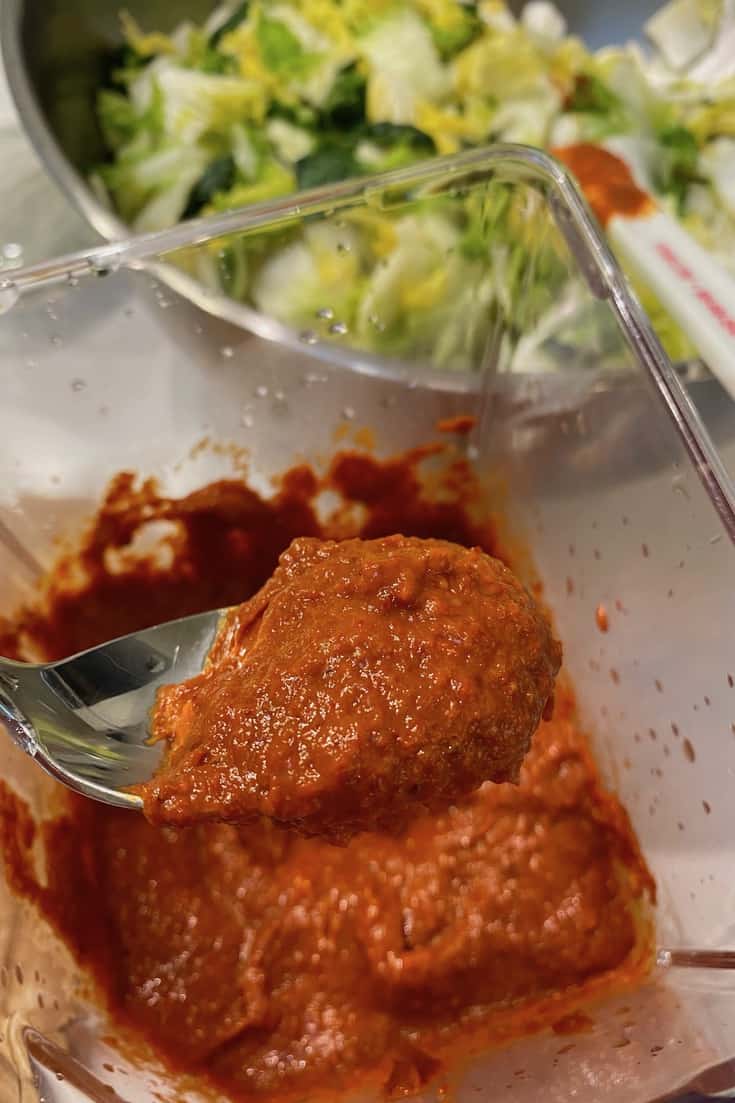
5. Cut the carrots into matchsticks shapes.
6. Slice the red chili peppers into thin slices.
7. Add the puree gochugaru mixture, carrots, chili peppers, and chopped scallions to the cabbage mixture and mix well.
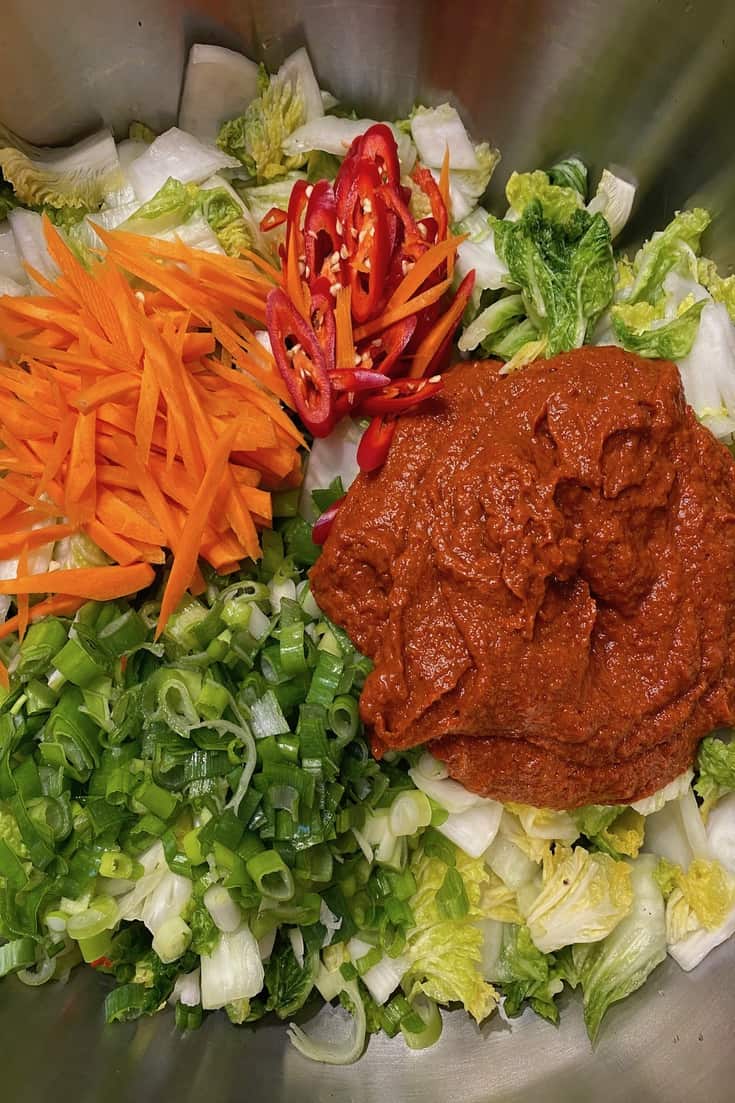
You may want to wear a pair of disposable food safe gloves for mixing since your hands may get stained from the gochugaru. And smell like garlic.

8. Place the cabbage in a large glass jar - a large mouth glass jar works really well since you'll be taking out kimchi every time you want to eat it.
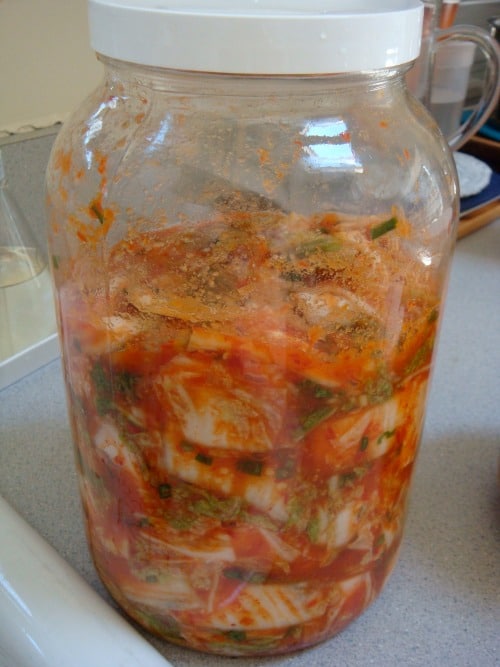
9. Take a large spoon and push down the cabbage until all are submerged in the liquid.
10. Store in room temperature ( 75 °F) for a couple of days. Don't put the lid on too tight. Burp the bottle after a day or two or when you see bubbles forming on top.
11. After a day or two, depending on how warm the room temperature is, move the jar to the refrigerator for future consumption.
P.S. My mom asked me how I made such a great tasting kimchi so simply! Now that was a compliment!
So if you want to be "lean" and healthy like us, Koreans, start consuming massive amounts of kimchi. Just make sure your partner has some too so that you won't reek of kimchi breath.
Serving Suggestions
Kimchi is usually served as a side dish to complement various dishes but it has been used as a garnish for burgers and even hotdogs. And when kimchi becomes over ripe, you can use it to make Korean Style Pancakes, and Kimchi Fried Rice. Try kimchi with the following dishes.
- You'll need rice, of course.
- Bulgogi made with traditional sirloin strips or ground beef.
- Galbijjim
If you make this recipe, please rate it below. I'd love to find out how it turns out for you.
➡️ Subscribe to our YouTube Channel for more recipes and tips. And follow @drkarensle on Pinterest, Facebook, Instagram and say "Hello!" 👋
💌 I would love to receive more posts like these in my inbox! SIGN ME UP for FREE newsletters!
Recipe
Authentic Korean Kimchi Recipe
Equipment
- 2 Large Mixing Bowls
- 1 Wide Mouth Gallon Jar
- Cutting Board
- Knife
Ingredients
- 3 Napa Cabbages
- ½ c 1 C coarse sea salt
- 1 c Gochugaru or Korean Pepper Flakes medium coarse
- 10 cloves garlic
- 1 Med yellow onion
- 2" ginger peeled
- 1-2 c cold filtered water for kimchi paste
- ¼ c fish sauce optional or omit if vegan
- ¼ c fermented baby shrimp optional or omit if vegan (*See notes)
- 2 carrots cut in matchsticks
- 2 spicy chili peppers sliced thinly
- 1 c chopped scallions
Sugar Options, used separately
- ½ c cooked white rice
- 1 c cold filtered water
Or
- 3 tablespoon sugar
Or
- 2 apples peeled and cored
Instructions
- Take off the outermost leaves from the napa cabbages that are dirty and wilted. With a knife, cut the head down the middle for about 2 inches and separate the rest of cabbages in half with your hands. Fill the big bowl with cold water, and wash the cabbages while separating each layer carefully. Wash in between the leaves thoroughly to rid of all the dirt hidden within the leaves.
- Once the leaves are clean, drain well, chop the leaves in one-inch widths and put them in a large mixing bowl. Sprinkle salt evenly - about 1 teaspoon of salt to a hand full of cabbage, in layers until all the cabbage pieces are mixed in salt. Cover loosely, and store the cabbage in a cool place overnight - or for at least 5 hours.
- There will be a little bit of liquid formed in the bottom of the bowl when the leaves get marinated in salt. Mix the cabbage mixture and then, rinse under cold water to taste. If it's salty enough, then, you are ready to proceed but if it's not, then, add more salt, one teaspoon at a time. If you add more salt, wait another a couple of hours, and then, taste again. If it's too salty, rinse the cabbages before adding the rest of the ingredients.
- If you are happy how salty it is, then, you are ready to add the rest of the ingredients.
- If you want to use the rice slurry, add ½ white rice with 1 cup of water to the blender with these ingredients. If you want to use sugar, use 3 tablespoon of white sugar. If you want to use fruits, cut them in big chunks and add with the rest of the ingredients in the blender.
- Add fish sauce, fermented shrimp, garlic, onion, ginger, gochugaru, and rice slurry or sugar or fruits, if you're using, to a food processor or a blender (don't use the jar you use to make margaritas, otherwise, your guests won't like the garlic tasting margaritas after making kimchi in it) and puree. If the mixture is too thick, add more water until the consistency becomes like ketchup.
- Cut the carrots into matchsticks shapes.
- Slice the red chili peppers into thin slices.
- Add the puree gochugaru mixture, carrots, chili peppers, and chopped scallions to the cabbage mixture and mix well. You may want to wear a pair of disposable food safe gloves for mixing since your hands may get stained from the gochugaru. And smell like garlic.
- Place the cabbage into a large glass jar - a large mouth glass jar works really well since you'll be taking out kimchi every time you want to eat it.
- Take a large spoon and push down the cabbage until all are submerged in the liquid.
- Store in room temperature ( 75 ºF) for a couple of days. Don't put the lid on too tight. Burp the bottle after a day or two or when you see bubbles forming on top.
- After a day or two, depending on how warm the room temperature is, move the jar to the refrigerator for future consumption.

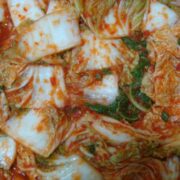
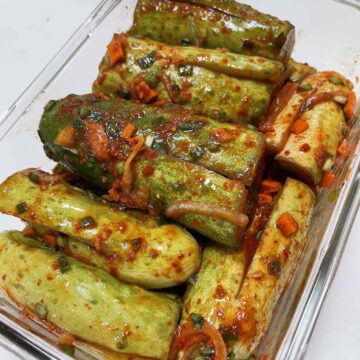
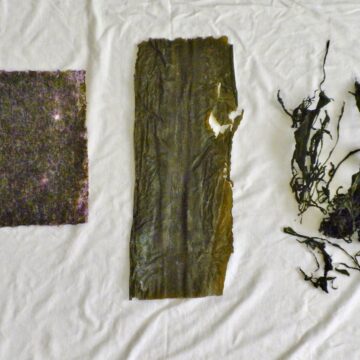
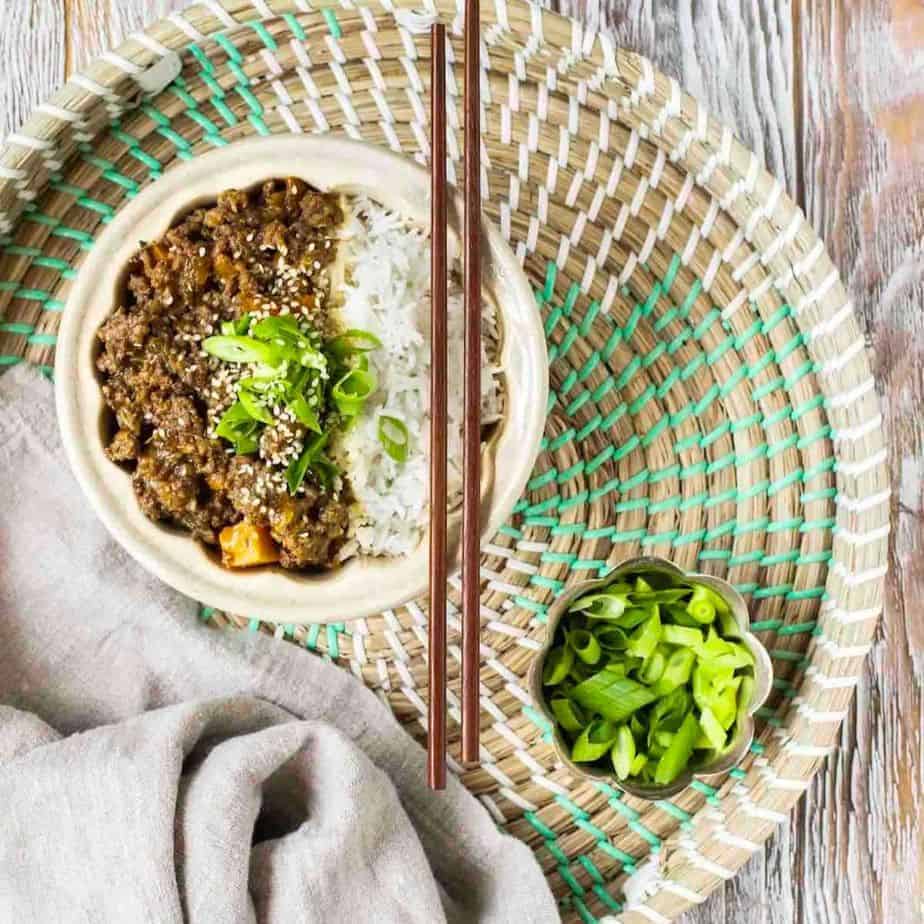

Laney says
Hi Doctor,
I have a question about the sodium content in kimchi and whether it is okay to make kimchi using less salt. Will that compromise the fermentation of the cabbage or the taste?
Thank you.
Dr. Karen Lee says
Hi Laney,
If you use less salt, it'll ferment much quicker but also, there's a risk of mold. So you'd have to watch the kimchi more carefully after you've seasoned it. You can leave the jar in room temperature - about 65-70 degrees - for a day and put it in the refrigerator to stop the mold from growing but you'll also stop the fermentation process. It's a fine balance.
Aden Mikus says
how large is a serving size?
Dr. Karen Lee says
Hi Aden,
That's a great question. It's a bit complicated and unfortunately, I didn't have the capability to use units other than 'servings' to show the yield. But 3 cabbages made about 3/4 gallon of kimchi. So depending on how much kimchi you consume, the serving size will differ. I added about the serving size in the notes on the recipe. Thanks for asking this important question. I'll have to contact the recipe card developer about this.
k says
I love that the women used to do the work together! What a wonderful thing.
Dr. Karen says
It's a great way to share and support each other! I still get together with my Mom when we make kimchi for the winter. We have a great time and we eat lots of delicious food!
Dr. Karen Lee says
grokgrub I bought mine at Sam's Wholesale Club but you can use any red pepper types, besides bell pepper.
Rachel Ball says
Kimchi is one of my favorite things about Korean restaurants. 🙂
grokgrub says
Where would I find “Ancient Sweet Red Pepper”?
Natalie Burns says
Yum!!
Susanne Runion says
I love Kimchi.
PhyllisShreve says
Hi Karen,
Thanks for de-mystifying!!! I still have one question for you: did you drain the liquid from your cabbage after the salting and soaking process?
I started some kim chee last night. i made a red batch and a green batch with European cabbages instead of oriental cabbage. I used about 1.5 tablespoons of salt in each batch. I didn't drain the liquid yet. I'm not sure if i should keep the liquid or not ?
Most recipes that I have seen use tons of salt, then require rinsing. I was trying to avoid all of the waste and rinsing. I haven't checked the results today. I also put my kit into the fridge;I din't leave it out more than three hours.
What do you think?
Dr. Karen Lee says
PhyllisShreve I think you may need more salt if you are using regular cabbages since they are thicker and tougher. And I wouldn't keep them in the fridge....room temp is best. And if you washed the cabbages before salting, you don't have to drain the water. My mom is neurotic about cleanliness and she washes before AND after. I don't. I wash the cabbage before salting and keep the liquid, after adjusting for the saltiness.
Tommy says
The two most awesome dishes, WOW. I can pass the smell with on problem, its the taste that I'm after. Thanks, good job. I will try this.
Mary says
Thanks so much for sharing this! I've enjoyed kimchi in Korean restaurants, but was mystified as to how it might be made. I've heard that fermented foods are very good for us, and I love that I now know how to make some at home.
Dr. Karen Lee says
If you make it at home, it tastes even better!
Becky says
Oh man, awesome!! I love kimchi, though it took me a while to come around to it. I had it not too long ago rolled up in sushi. It was so good!
Dr. Karen Lee says
So then, you know why TSA wouldn't like it in our carry on luggage. ;D But glad you acquired the taste for it! Try it on pizza next time. With a little bit of spic kimchi on top of veggie pizza is indescribable!